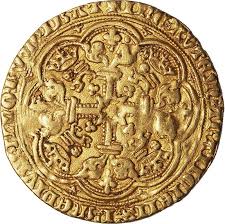The introduction of the gold noble in 1344 CE was not just a financial move—it was a major economic strategy that reshaped England’s trade and international influence. As England engaged in the Hundred Years’ War (1337–1453 CE), King Edward III recognized the need for a stable gold currency to support commerce, taxation, and war financing. The gold noble played a key role in boosting England’s trade dominance, especially in the wool market, and strengthening its position against France and other European rivals.

The Gold Noble & England’s Wool Trade
During the 14th century, England’s economy was built on wool exports, particularly to Flanders (modern-day Belgium), which was the center of Europe’s textile industry. Wool was often referred to as “the jewel of the realm” because it was the country’s most valuable commodity.
A. Wool as a Financial Asset
- The English Crown heavily taxed wool exports, making it a crucial source of revenue.
- Wool shipments were used as collateral for loans from Italian and Flemish bankers, with repayment often made in gold nobles.
- The introduction of a stable gold currency allowed merchants to price and conduct wool trade more efficiently.
B. The Staple System & Gold Transactions
- England established “wool staples” (official trade centers) where wool was taxed and sold in gold.
- These staples ensured that England’s gold reserves grew, as merchants had to pay in gold nobles or other gold-backed currencies.
- The most important wool staple was Calais, a key English-controlled city in France.
✅ Result: The gold noble allowed England to dominate the wool trade, making it financially strong despite the ongoing war.
International Trade & The Gold Noble’s Acceptance
Unlike earlier English currencies, the gold noble was quickly accepted in international markets, particularly in:
🔹 The Low Countries (Flanders, Bruges, Ghent) – England’s main wool trade partners used gold nobles for payments.
🔹 Italian City-States (Florence, Venice, Genoa) – Italian bankers accepted gold nobles alongside florins and ducats.
🔹 Hanseatic League (Baltic & Northern Europe) – German merchants used nobles in trade with England and Scandinavia.
✅ Result: The gold noble became England’s first truly international coin, increasing trade efficiency and credibility in European markets.
Competing with the Florin & Ducat
By the 14th century, Europe’s leading trade coins were:
- Florentine Florin (1252 CE) – Used across Europe, especially in banking.
- Venetian Ducat (1284 CE) – The dominant coin in Mediterranean trade.
How the Gold Noble Compared
- Heavier than the florin and ducat – Made it ideal for large transactions.
- More trusted than debased silver currencies – Strengthened England’s economy.
- Symbolized England’s naval and military power – Featured a warship design to showcase dominance.
✅ Result: The gold noble gave England a stronger economic standing in Europe, allowing it to compete with major financial powers like Italy and the Low Countries.
The Gold Noble’s Role in Taxation & Government Finance
A stable gold currency also allowed Edward III to:
- Collect taxes more efficiently in gold nobles instead of fluctuating silver coins.
- Raise war funds by offering gold-backed bonds to merchants and bankers.
- Reduce England’s reliance on foreign gold coins, keeping more wealth inside the kingdom.
✅ Result: The gold noble became essential to England’s financial independence, allowing it to fund the Hundred Years’ War without completely draining its economy.
Conclusion: The Gold Noble’s Lasting Economic Impact
The introduction of the gold noble in 1344 CE was more than just a new coin—it was a powerful economic tool that:
✅ Strengthened England’s wool trade, its most valuable industry.
✅ Increased England’s role in international markets, making the noble a trusted trade coin.
✅ Allowed England to compete with Florence and Venice in global finance.
✅ Provided the financial foundation for war funding, taxation, and government borrowing.
The gold noble’s success set the stage for future English gold coins like the angel (1464 CE) and the sovereign (1489 CE), reinforcing England’s financial power for centuries.
